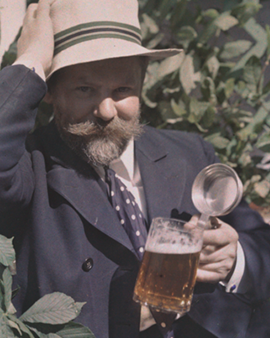


Photography and painting together produce a unique form of art, a medium that makes it possible to capture moments for eternity, capturing the beauty and emotion that lie hidden within them. Frank Eugene Smith (1865-1936), a master of both disciplines, used his talents to remarkably capture and interpret the world around him. Born in New York, he found a home for his art in both America and Germany, where he worked as a painter, etcher, and photographer. Frank Eugene expanded the range of his artistic abilities during his training at the Academy of Fine Arts in Munich.
It was during this time that he discovered his passion for photography and exhibited his work for the first time in Alfred Stieglitz Camera Club in 1889. Critics at the time described his images as "unphotographic photographs". After completing his studies, he returned to New York, where he worked as a set designer and portrait painter, specializing in portraits of famous theater actors. In Germany, however, he found the recognition he sought for his Art Nouveau painting, and he took German citizenship.
In his subsequent creative period, he returned to his photographic roots and founded Photo-Secession in New York with Stieglitz and Edward Steichen. His continued teaching and commitment to pictorialist photography at the Lehr- und Versuchsanstalt für Fotografie in Munich had a significant impact not only on his career, but also on the history of photography. He established the world's first chair of artistic photography at the Academy of Graphic Arts and Book Trade in Leipzig, underscoring his role as a pioneer and teacher in the field.
Eugene achieved international fame for his published heliogravures in the photography magazine Camera Work, in which he applied the romanticizing style of painting to his photographs. By processing his photographic negatives with an etching needle, he was able to enhance the graphic character of his prints and give his works a sensual aspect reminiscent of nude studies. Among his most famous works in this manner are "Adam and Eve" and "The Horse".
His legacy lives on today in our high quality fine art prints, reproduced with the utmost care to match the depth and complexity of his original works. Eugene's stunning works, which transcended the boundaries of traditional photography and painting, thus remain an inspiring part of our artistic heritage. With his work on display in the Alfred Stieglitz Collection at the Metropolitan Museum of Art as well as at Hamburg's Museum für Kunst und Gewerbe and many other museums, Frank Eugene remains an unforgettable figure in the history of photography and painting.

Photography and painting together produce a unique form of art, a medium that makes it possible to capture moments for eternity, capturing the beauty and emotion that lie hidden within them. Frank Eugene Smith (1865-1936), a master of both disciplines, used his talents to remarkably capture and interpret the world around him. Born in New York, he found a home for his art in both America and Germany, where he worked as a painter, etcher, and photographer. Frank Eugene expanded the range of his artistic abilities during his training at the Academy of Fine Arts in Munich.
It was during this time that he discovered his passion for photography and exhibited his work for the first time in Alfred Stieglitz Camera Club in 1889. Critics at the time described his images as "unphotographic photographs". After completing his studies, he returned to New York, where he worked as a set designer and portrait painter, specializing in portraits of famous theater actors. In Germany, however, he found the recognition he sought for his Art Nouveau painting, and he took German citizenship.
In his subsequent creative period, he returned to his photographic roots and founded Photo-Secession in New York with Stieglitz and Edward Steichen. His continued teaching and commitment to pictorialist photography at the Lehr- und Versuchsanstalt für Fotografie in Munich had a significant impact not only on his career, but also on the history of photography. He established the world's first chair of artistic photography at the Academy of Graphic Arts and Book Trade in Leipzig, underscoring his role as a pioneer and teacher in the field.
Eugene achieved international fame for his published heliogravures in the photography magazine Camera Work, in which he applied the romanticizing style of painting to his photographs. By processing his photographic negatives with an etching needle, he was able to enhance the graphic character of his prints and give his works a sensual aspect reminiscent of nude studies. Among his most famous works in this manner are "Adam and Eve" and "The Horse".
His legacy lives on today in our high quality fine art prints, reproduced with the utmost care to match the depth and complexity of his original works. Eugene's stunning works, which transcended the boundaries of traditional photography and painting, thus remain an inspiring part of our artistic heritage. With his work on display in the Alfred Stieglitz Collection at the Metropolitan Museum of Art as well as at Hamburg's Museum für Kunst und Gewerbe and many other museums, Frank Eugene remains an unforgettable figure in the history of photography and painting.
Page 1 / 1






